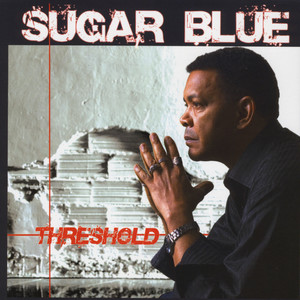
- 歌曲
- 时长
简介
"...his first-rate, virtuoso harmonica playing always satisfies the true blues connoisseur in the attack and fluid lines he doles out..." - ALL MUSIC "...gritty and soulful harmonica playing: this album is one that celebrates and mixes the roots of music that has helped shape the culture in America." - RADIO INDY “…like a true genius, his sound transcends genres" - BLURT “Blue recalls other instrumentalists without duplicating anyone. He plays runs that suggest the chromatic work of Stevie Wonder and Toots Thieleman, as well as jazz trumpeters and saxophonists.” - HYPERBOLIUM “This one is heavy on the side of Soul with traces of Jazz, but does get into some rather heavy Blues. Sugar Blue has tapped into the emotional state that is common to us all and is playing off of that. The musicianship on this one is no less than immaculate with Sugar’s vocal and harp work being more refined than ever. – BILLTOWN BLUE NOTES "...the eleven cuts herein (nine of them originals) show a bold new direction for Blue, incorporating soul, rock, jazz, and funk into his deep-seated affinity for the blues" - NASHVILLE BLUES SOCIETY — “We have chosen the title Threshold because the tunes open new musical territory for us,” says bluesman Sugar Blue of his new album, due out January 26, 2010 on Beeble Music. The album follows the acclaimed 2007 album Code Blue, which hinted at a widening musical path. In addition to Sugar Blue on harmonica and vocals, Threshold features guitarist Rico McFarland (Albert King, Otis Clay, Syl Johnson, James Cotton, Lucky Peterson); guitarist Moto Makino (Los Lobos); Noel Neal, bass; James Knowles, drums; and Ilaria Lantieri, bass; with guests Bill Dickens, the “Buddha of Bass” (Stevie Wonder, Aretha Franklin, Janet Jackson, George Michael, Jerry Harrison) and percussionist Samuel Torres (Pancho Sanchez, Tito Puente, Chick Corea, Pete Escovedo). The album, produced by Sugar Blue, was recorded in both Chicago and Tokyo. The nine original songs were co-written by Blue with Lantieri and Makino and range from blues to rock, funk, jazz and ballads. “Stop the War” is a cry for peace punctuated by Dickens’ bass line. “Cotton Tree” is an homage to living blues harmonica legend James Cotton, mentor to Sugar Blue as well as hundreds of harp players worldwide. “Noel News” celebrates the strength of the people of New Orleans. “Ramblin’” is a duet featuring Blue on both harmonica and Chromonica, a bass harp. The album also contains two coverby Junior Wells and “Trouble” the Lieber & Stoller-penned Elvis Presley hit. A spoken interview with Blue finishes the CD. The Grammy Award-winning harmonica virtuoso was born James Whiting in Harlem, New York. Influenced by artists as diverse as Lester Young and Bob Dylan, Blue began his career playing on the streets, and later recorded with Brownie McGhee, Roosevelt Sykes and Victoria Spivey. He relocated to France on the advice of expatriate Memphis Slim, and while there hooked up with the Rolling Stones, who invited him to play on their Some Girls, Emotional Rescue and Tattoo You albums. Offered an indefinite session spot with the band, he turned down the offer in favor of returning to the U.S. Before leaving Europe, he recorded two albums, Crossroads and From Paris to Chicago. In Chicago, Blue worked with and learned from harmonica legends Big Walter Horton, Carey Bell, James Cotton and Junior Wells. He played in the Chicago Blues All-Stars with friend and mentor Willie Dixon and contributed to Dixon’s Grammy-winning 1988 album Hidden Charms. He sat in with Fats Domino, Ray Charles and Jerry Lee Lewis for the Cinemax special Fats Domino and Friends. And he appeared onscreen and in the musical score of Alan Parker’s acclaimed 1987 thriller Angel Heart, starring Robert De Niro. Best known for his signature riff on the Rolling Stones’ “Miss You,” Blue performed his own version of the song on his 1993 Alligator Records album Blue Blazes, followed up with In Your Eyes. As to how the name Sugar Blue came to be, “I needed a nickname and all the good ones were taken — Muddy Waters, Blind Lemon, Sonny Boy,” Blue explains. “One night a friend and I were leaving a Doc Watson concert when somebody threw out of the window a box full of old 78s. I picked one up and it said ‘Sugar Blues’ by Sidney Bechet. That’s it! I thought it was perfect. So here I am.” Sugar Blue incorporates what he has learned into his visionary and singular style, technically dazzling yet wholly soulful. He bends, shakes and spills flurries of notes with simultaneous precision and abandon. And he zings too. His distinctive throat tends to be overlooked — a rich voice with a whisper of huskiness. Of the Threshold album, Blue says, “I believe that the greatest threshold of all is love because it is the fount from which all human life springs. Life echoes the sounds of our interactions: joy, sadness, heartache, passion, loneliness, intimacy, celebration or solemn occasion. We have tried to give voice to these feelings in this musical offering.”







